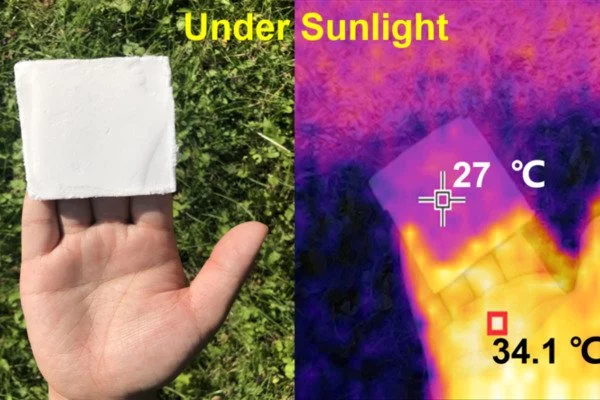People attempt to beat the heat during the summer. Running air conditioners, on the other hand, is expensive and wasteful. At present, scientists have developed a lightweight foam composed of wood-based cellulose nanocrystals reflecting sunlight, liberating absorbed heat, and is thermally insulating. The material has the potential to reduce cooling energy requirements in buildings by more than a third.
Summertime is almost here, a time when many people try to beat the heat. However, running air conditioners constantly can be costly and wasteful. Researchers have developed a lightweight foam made of wood-based cellulose nanocrystals that reflects sunlight, emits absorbed heat, and is thermally insulating, as reported in ACS’ Nano Letters. They believe the material could cut cooling energy needs in buildings by more than a third.
Despite the fact that scientists have developed cooling materials, they have drawbacks. Some materials that passively release absorbed heat allow a lot of heat to pass through to buildings during the summer months’ direct midday sun. And other materials that reflect sunlight don’t work well in hot, humid or cloudy weather. So Yu Fu, Kai Zhang, and their colleagues set out to create a strong material that could reflect sunlight, passively release heat, and prevent unwanted heat from passing through.
The researchers created a cooling material by connecting cellulose nanocrystals with a silane bridge, then freezing and freeze-drying the material under vacuum. The nanocrystals were vertically aligned in this process, resulting in a white, lightweight foam that reflected 96 percent of visible light and emitted 92 percent of absorbed infrared radiation.
Yu Fu and Kai Zhang
The new cooling material is made out of cellulose nanocrystals, connected with a silane bridge before freezing and freeze-drying the material under a vacuum. This process vertically aligned the nanocrystals, making a white, lightweight foam, which reflected 96% of visible light from the Sun and emitted 92% of the infrared radiation it absorbs.
Researchers placed the material over an aluminum foil-lined box sitting outside at noon to test its cooling ability. The material kept the temperature inside the box 16 degrees Fahrenheit lower than the temperature outside. Furthermore, when the air was humid, the material kept the inside of the box 13 degrees F cooler. The team estimated that applying the foam to a building’s roof and exterior walls could reduce its cooling energy needs by 35.4 percent on average.
When the cellulose-based foam was compressed, its cooling ability decreased, revealing tunable cooling properties. Because the performance of the wood-based cellulose foam can be tuned depending on weather conditions, the researcher believes the technology could be used in a variety of environments.

The researchers created a cooling material by connecting cellulose nanocrystals with a silane bridge, then freezing and freeze-drying the material under vacuum. The nanocrystals were vertically aligned in this process, resulting in a white, lightweight foam that reflected 96 percent of visible light and emitted 92 percent of absorbed infrared radiation. When draped over an aluminum foil-lined box sitting outside at noon, the material kept the temperature inside the box 16 degrees F cooler than the temperature outside. Furthermore, when the air was humid, the material kept the inside of the box 13 degrees F cooler. The cooling ability of the cellulose-based foam decreased as it was compressed, revealing tunable cooling properties.
The team calculated that placing the foam on the roof and exterior walls of a building could reduce its cooling energy needs by an average of 35.4 percent . Because the wood-based cellulose foam’s performance can be tuned depending on weather conditions, the researcher say that the technology could be applied in a wide range of environments.
To create a cooling material, the researchers connected cellulose nanocrystals with a silence bridge before freezing and freeze-drying the material in a vacuum. The nanocrystals were vertically aligned during this process, resulting in a white, lightweight foam that reflected 96 percent of visible light and emitted 92 percent of absorbed infrared radiation.
When the material was placed over an aluminum foil-lined box sitting outside at noon, it kept the temperature inside the box at 16 degrees Fahrenheit, which was cooler than the temperature outside.
The authors gratefully acknowledge funding from the German Research Foundation (DFG), the Lower Saxony Ministry of Science and Culture, the National Natural Science Foundation of China, the Jiangsu Specially Appointed Professorship Program, the Science and Technology Innovation Project for Overseas Students of Nanjing City, the Jiangsu Province Postgraduate Research & Practice Innovation Program, National First-class Disciplines (PNFD), and the Jiangsu Government Scholarship for Overseas Students.
According to the researchers, the wood-based cooling foam could pave the way for the development of high-performance, thermal-regulating materials for energy conservation.















